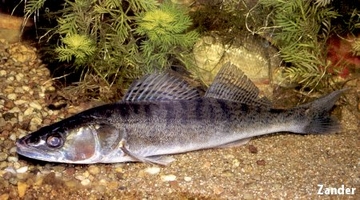The Zanderposted on 8 February 2015 | posted in Hints and TipsCommon Name: Zander Latin name: Stizostedion lucioperca  Record weight: Despite growing to over twice this size in Europe, the British record has only slowly increased to 19lb 5oz 8 drams. This huge fish, caught by D. Lavender from a Fen Drain in 1998 is by far the largest zander ever caught. Distribution: Although zander are a relative newcomer to the British Isles, having been introduced to the Great Ouse Relief Channel in Cambridgeshire during the latter half of the last century, zander are spreading rapidly. Unlike many other species of fish that have been introduced by man, the conditions in the UK appear to favour the zander and, in particular, they seem able to spawn in a wide range of British waters. This has led to the zander spreading rapidly through the inter-linked Fen river system, into the midlands canal network and into the River Severn catchment. Despite this rapid spread, in most fisheries zander do not appear to represent a major threat to fisheries. Whilst zander numbers initially increase rapidly within 2-3 generations the fish become self-regulating as the larger fish predate heavily on the small fish. Populations stabilise at a low level and once again level out. The exception to this pattern is in heavily coloured water, such as busy canals. Here zander are a very effective predator and populations tend to be much higher having a negative impact on the populations of small silver fish, such as roach and gudgeon. Features: Once commonly known as the pike-perch, this is actually a very apt name for the zander as they do resemble a cross between these two species. Nevertheless, zander are not related to these species, but share a niche between them. Zander have a pointed head with a large mouth, similar to a pike, with a pair of large gripping teeth in both the upper and lower jaws. Behind these are rows of smaller teeth that give the zander a rather ferocious look. The zander has the rough feel and spiked dorsal fins of the perch, protecting small fish from predation, particularly from pike and herons. The zander has a very large eye, perfect for hunting in murky water and under low light conditions that hints towards it's favoured hunting strategy. Diet: Zander mouths have a smaller gape than pike, so although large fish are almost exclusively piscivorous, they take much smaller prey than a pike of similar size. Favoured prey are roach and gudgeon of between one and four ounces. These slim bodied fish are easy for the zander to handle and are also the dominant fish species in their favoured environments. Spawning: Zander spawn during March and April forming loose aggregations around suitable habitat. Zander tend to spawn on submerged tree stumps, branches and reeds, although it is suspected that they can also spawn on plants and even canal pilings. Growth: Zander are a relatively fast growing species and appear quite short lived. Fish can make ten pounds in under a decade as they have a high protein fish diet. The growth of zander varies greatly from water to water. In the canals, where the fish feed on small prey and spawn frequently, the average fish weighs only a couple of pounds. This is an ideal strategy to make use of the abundant small prey. In less suitable environments the zander spawn less frequently, use more energy for growth and so eventually grow much larger. Stillwaters seem particularly suitable for growing outsized zander, although most captures are accidental. |








.jpg)
.jpg)





